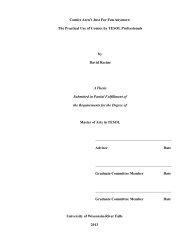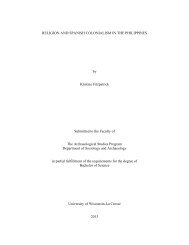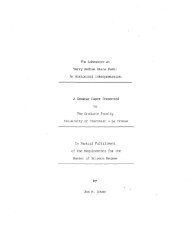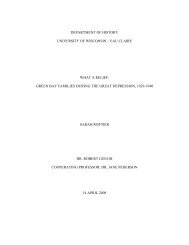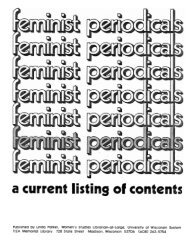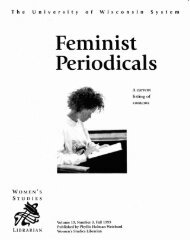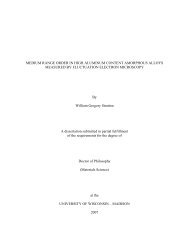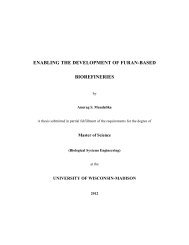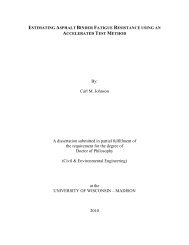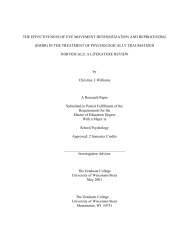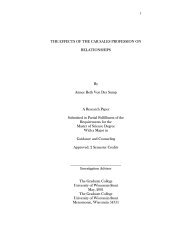1 CONFRONTS THE TEXTBOOK.. - MINDS@UW Home - University ...
1 CONFRONTS THE TEXTBOOK.. - MINDS@UW Home - University ...
1 CONFRONTS THE TEXTBOOK.. - MINDS@UW Home - University ...
You also want an ePaper? Increase the reach of your titles
YUMPU automatically turns print PDFs into web optimized ePapers that Google loves.
Page 12 Faninist Collecliom v.16, no. 1, Fall 1994<br />
"Mother Wit" in African-American women's autobiog-<br />
raphies.<br />
Part III contains essays on individual humorists,<br />
ranging historically from Sarah Kemble Knight's 1704<br />
journal to an analysis of stand-up comic Kate Clinton.<br />
Other authors discussed are Frances Miriam Whitcher,<br />
Anna Cora Mowatt, Fanny Fern, Marietta Holley, Alice<br />
Duer Miller, Florence Guy Seabu~y, Dorothy Parker and<br />
Zora Neale Hurston.<br />
business, I do not wish to dismunt the fact that it is also<br />
a lot of fun! One more reason to read all of the texts<br />
discussed here is for simple pleasure; these critics enjoy<br />
what they are doing and it shows in the wit and enthusi-<br />
asm of their prose. Although it is becoming harder to<br />
keep up with the proliferation of women's humor schol-<br />
arship, it would be ludicrous to complain about this re-<br />
cent phenomenon. Perhaps Mae West said it best when<br />
she asserted that, "Too much of a good thing can be won-<br />
derful."<br />
All of the essays in this volume are illurninat and [Debra Beilke is pursuing her Ph.D. in English at<br />
enjoyable to read; the main drawback is that all but one the <strong>University</strong> of Esconsin-Madison. Her dissertation<br />
of the essays (the one on Mowatt) have been previously is on identity and humor in Southern Renaissance nov-<br />
published. The book's value, therefore, lies not so much els. She is not amused by the amount of time it is taking<br />
in advancing knowledge as in the convenience of having her to complete her degree.]<br />
all these essays (some of which are hard to find) together<br />
in one volume.<br />
Although the study of women's humor is a serious<br />
<strong>THE</strong> HUBRIS OF WRITING SURVEYS, OR A FEMINIST<br />
<strong>CONFRONTS</strong> <strong>THE</strong> <strong>TEXTBOOK</strong><br />
by Meny Resner-Hanks<br />
[Editors' note: Versions of thispaper were presented at<br />
'jlttending to Women in Early Modem Eumpe, " a con-<br />
ference held at the Center for Renaissance andBamque<br />
Studies at the <strong>University</strong> ofMaryland, Baltimore County<br />
and at "Women 's History: Digging, Doing, Disseminat-<br />
ing, "a Women 's History Outreach Conference sponsored<br />
by the UW-Madison Division of <strong>University</strong> Outreach. A<br />
longer version will appear in Attending to Women in<br />
Early Modem Europe, forthcomingfrom the <strong>University</strong><br />
of Delaware Press.]<br />
Just when we think women's history or feminist lit-<br />
erary or art historical analysis has become fully main-<br />
stream, when we listen contentedly to complaints at con-<br />
ferences - such as, "All there is these. days is gender,<br />
gender, gender" (overheard in a strong Gennanic accent<br />
at the AmericanHistorical Association several years ago)<br />
--when graduate students comment that they're now read-<br />
ing more Toni Monison than Wdiam Faulkner, some-<br />
thing reminds us sharply that we're still considered some-<br />
what of a fringe element. This message came home to<br />
me most forcefully five years ago, when I was fust con-<br />
tacted by the editors for a new Cambridge <strong>University</strong> Press<br />
series. Now titled 'Wew Approaches to European His-<br />
tory," this series was designed, in the words of the pro-<br />
spectus, "to provide concise but authoritative surveys of<br />
major themes and problems in European history since<br />
the Renaissance." I was not in the first group of authors<br />
to be contacted, however, for when the editors at Cam-<br />
bridge initially defined the "major themes and problems"<br />
that warranted a survey, neither women nor gender nor<br />
the family appeared on the list. This rather glaring omis-<br />
sion was corrected later when the series editors asked<br />
me to do a survey on all three. My protests that I am not<br />
a family historian, and that (how many times do we have<br />
to say this?) women's and family histow are not the same<br />
thing, led to my topic being ''n&owed." Now all I was<br />
confronted with was the historv ofEurom women from<br />
1500-1750, from Portugal to Russia, with as much of the<br />
new scholarship on gender added in as I wanted.'<br />
I begin with this story not to be depressing, but<br />
to point out that when one turns from writing for spe<br />
cialists to writing for students, those students may not be<br />
the first obstacle one confronts. In fact, students taking<br />
upper-level European history courses --the intended au-<br />
dience for the Cambridge series -- may actually be more<br />
cognizant of women's history and writings ihan many<br />
editorial committees. Unlike books for upper-level his-<br />
tory courses in which material on women continues to be



